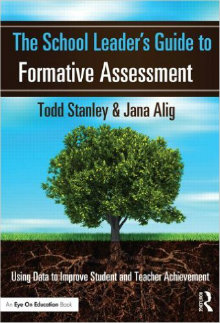A Leader’s Guide to Formative Assessment
The School Leader’s Guide to Formative Assessment: Using Data to Improve Student and Teacher Achievement
By Todd Stanley and Jana Alig
(Routledge/Eye on Education, 2014 – Learn more)

I don’t have many regrets about my career path from teacher to technology director to head of an independent school, but one of them is the fact that I have fewer daily interactions with students than I did when I was in the science classroom.
As I read books in the educational field I frequently think, “That’s a fantastic idea! I wish I could put that into practice in a classroom.” However, I often am only able to do that vicariously through recommending a strategy to a teacher and watching her implement it with her students.
I enjoyed reading this book by Todd Stanley and Jana Alig because it presents recommendations at a granular, classroom-based level that teachers will find very helpful.
Best of all, it’s also designed for use at a schoolwide level, where it has the potential for great impact. The authors walk school leaders from the ground up through the process of implementing common formative assessments in an effort to transform an entire school.
The case for formative assessments
Since I became a school head, I have enjoyed watching our teachers embrace the idea of using formative assessments to inform their instruction. Employing a variety of techniques from hand signals to hand-held whiteboards and dry erase markers to iPad-based technology tools, teachers are able to get instant feedback from their students about their understanding of skills and concepts.
Early in this book, Stanley and Alig build a persuasive case for the value of formative assessments for students, teachers, and schools. In fact, they model what they write about by opening the book with a pre-assessment to gauge what the reader already knows; short answers are presented at the end of each chapter.
The SCORE Process
At the heart of The School Leader’s Guide to Formative Assessment is the SCORE Process, which stands for Short Cycle Assessments Organized for Results and Expectations, and is adapted by the authors from an earlier work by Lang, Stanley, and Moore.
The SCORE Process takes teachers through the steps of creating and administering formative assessments based on the Common Core State Standards and their accompanying state tests, analyzing data from those assessments and adjusting instruction based on that data. The heavy emphasis on common (meaning “shared”) formative assessments, which are designed by teaching teams in the same subject or grade level, is not something I expected to encounter while reading this book, but I definitely see their value in schools larger than mine.
I particularly appreciated the book’s second chapter, which will help me work with my teachers to improve their assessments, and not only those of the formative type. In this chapter, the authors explain the concepts of reliability (the degree to which an assessment produces consistent results) and validity (whether an assessment measures the concepts or skills it is intended to measure.) In addition, the authors cover best practices in writing test items that ensure their validity.
One off-putting note
For me, one off-putting note in the book involved the step of the SCORE process dealing with the actual administration of common formative assessments.
In an effort to help school leaders get the most value from those assessments, the authors advise techniques such as schoolwide announcements in the days leading up to their administration and scheduling them in a way that mimics the state assessment schedule.
As the head of an independent school in which standardized tests do not have the high stakes that they do in public schools, I prefer to consider the value of formative assessments for their own sake and not as part of the greater testing landscape. However, the authors do present powerful data showing the value of formative assessment in improving student performance on high-stakes tests.
Plentiful resources
Stanley and Alig close their book with an appendix titled “The Principal’s Office,” an incredible collection of resources that are also downloadable and reproducible. These resources include detailed explanations of a variety of formative assessment techniques, guidelines for creating effective and valid assessment items, and templates for analyzing and reporting data.
The School Leader’s Guide to Formative Assessment is well worth digging into. If the reader is not already sold on the value of formative assessment, this book will make a difference. The step-by-step approach provided by the SCORE Process, along with the resources contained in “The Principal’s Office,” gives teachers and administrators the tools they need to implement a system of common formative assessments with the power to transform a school.
Erik Kreutner is the Head of Mason Preparatory School, a K-8 independent school in Charleston, South Carolina. Prior to becoming an administrator, he taught science and computer classes for 18 years at Mason Prep and was a swim coach for 25 years. The opportunity to start his career in middle school hooked Erik on a lifetime in education. He is also a board member for the Palmetto Association of Independent Schools.



































